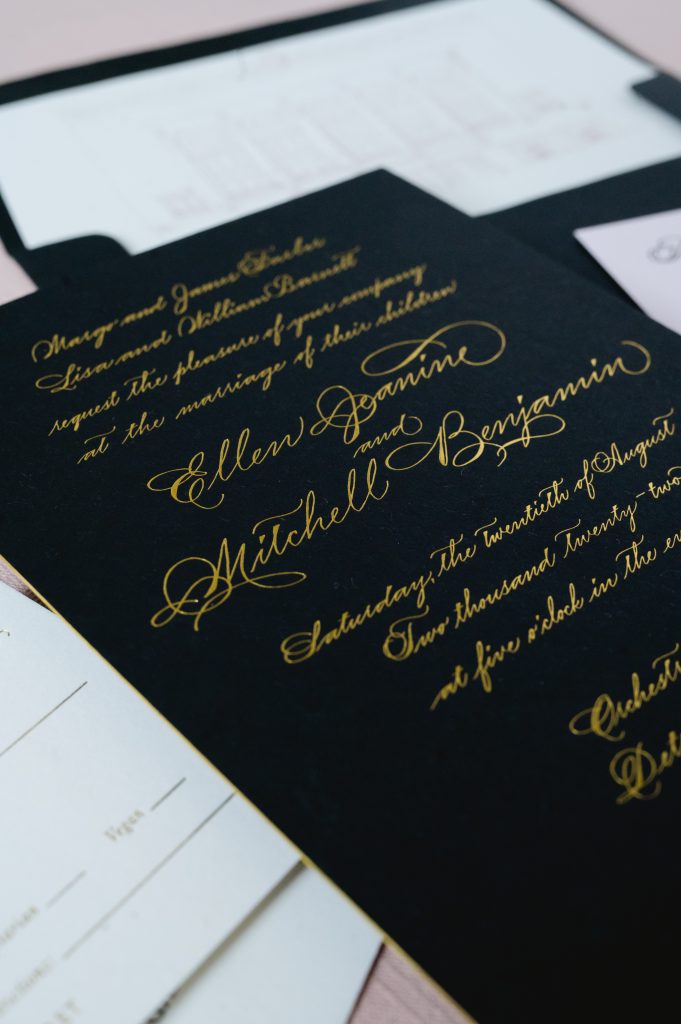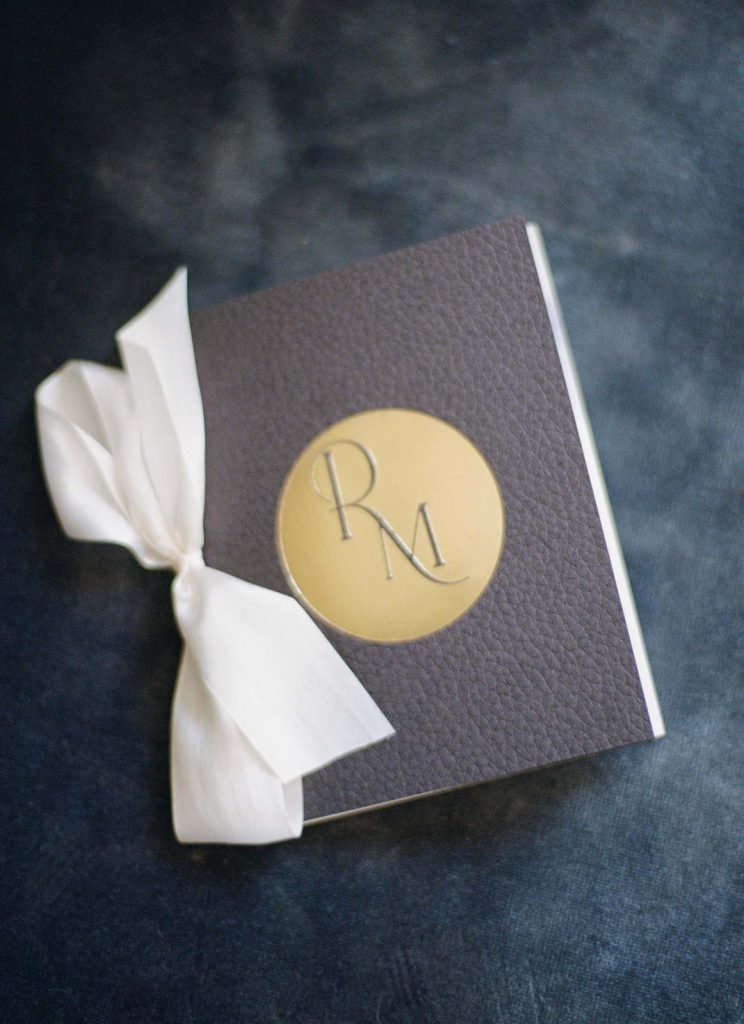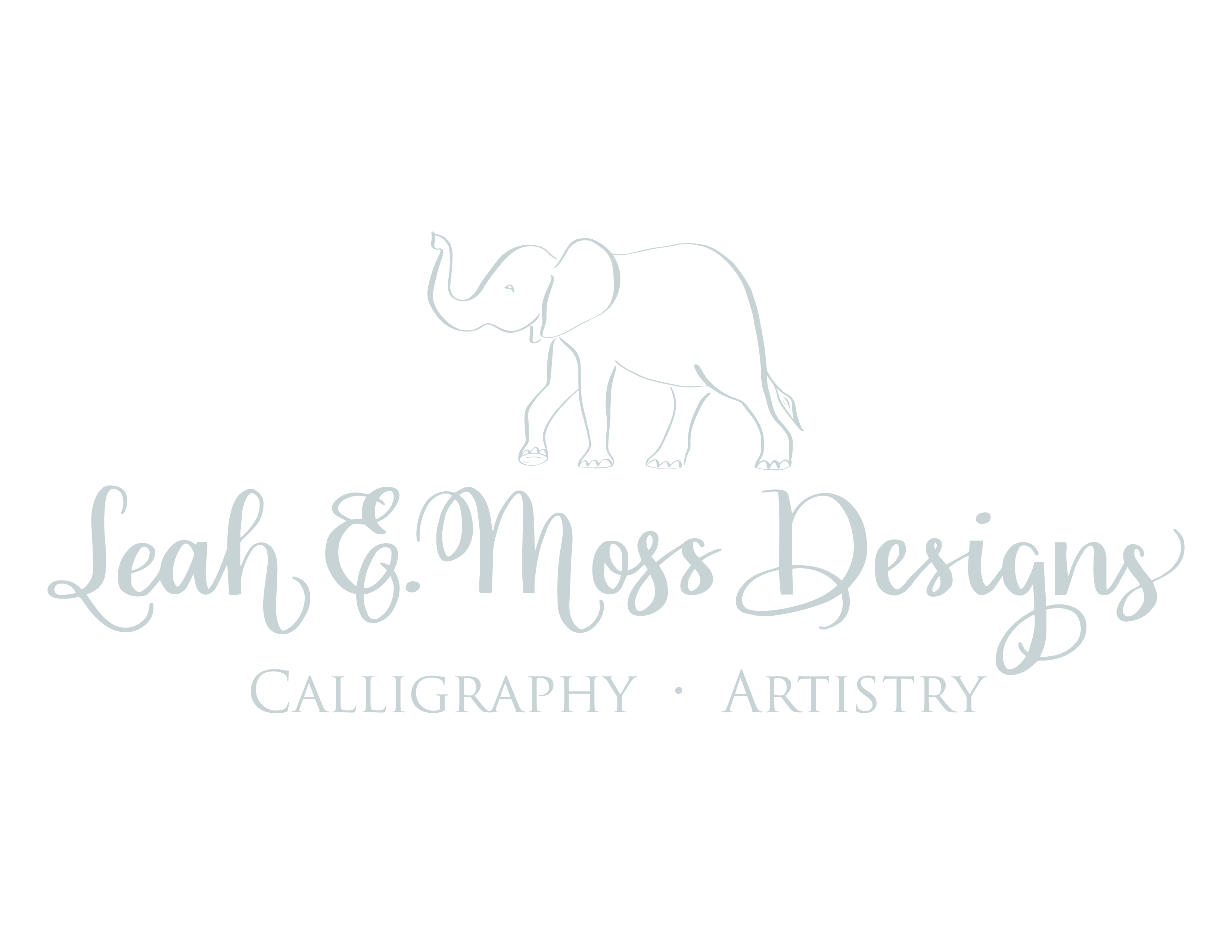
Most of my clients are total power couples – they really know their stuff! They’re smart and talented in their fields. But they’re often totally overwhelmed and uncertain about all of the wedding invitation printing options available to them. Yikes.
After helping so many couples navigate this as an invitations designer, I decided it was high time to write a blog post explaining these invitation printing options.
The featured invitation here mixes three print methods on the same card: letterpress for the base text, foil stamping for the headings, and embossing for the floral details. Let’s dive in to see what that means!
Digital/flat printing
With ink flat printed directly onto paper, digital printing is your most budget-friendly wedding invitation printing option. There is no texture left here with the printing – it is smooth on the surface of the paper. If you’re incorporating anything with multiple colors (such as watercolor painted elements or bold/bright patterns), you’ll have to print these digitally to achieve a multi-color end result. In more recent years, white ink digital printing has also become available, which works nicely for beautiful contrast on colored card stock.



Pros to digital printing:
- Cost! This is the least expensive print method. Invitations don’t have to break the bank, and printing digitally is a great way to respect your budget.
- Multiple colors. You can print all colors at once, for vibrant designs. If you’re incorporating a pet portrait, crest, floral/greenery design, map (the list goes on…), digital printing will offer a beautiful end result!
- Speed. This method is the fastest to produce, so if you’re on a time crunch, this is helpful.
Cons to digital printing:
- Flatness. There’s no texture/tactile experience with this, when running your hand over the printed piece.
- Thickness. Typically, the thickest cardstock that can be digitally printed upon is 110-120# cardstock (which is nice and not flimsy, but it’s not thick-thick, if you know what I’m sayin’). To get double thick cardstock with a digitally printed design, two thinner sheets have to be duplexed together – which is just a fancy term for “glued.”
Letterpress for your wedding invitation printing
Letterpress is a centuries-old artisan process. A plate is made with your design, and that’s pressed (by hand) into the paper with ink. Because a plate is made for the design, letterpress is printed one ink color at a time. If you have more than one color in the design, that means one plate (and manual print run) per color.
Your invitations have a deep impression and texture with your design. As your guests run their fingers over the paper, there’s a tactile experience. It’s luxe, timeless, and totally elegant – all my favorite things.



Pros to letterpress:
- Tactile experience. There’s something so luxurious about the deep, pillowy impression provided by this invitation printing option. Guests love it.
- Classic elegance. Because this is a centuries-old print method, it’s stood the test of time – and for good reason.
- Soft and delicate or bold and beautiful. This method lends itself to either end of the spectrum here. Depending on the ink color you choose, this is a soft, almost serene look – or a statement-maker!
Cons to letterpress:
- Cost! This method is done by hand, and the plate has to be made – so it costs more.
- One color at a time. Designs are limited to one-color print runs at a time, so you have to be comfortable with line-drawn artwork, rather than something more colorful.
- Timing. This method requires a bit more time to produce, given that the plate has to be made, and then the invitation itself is printed. If you’re really pressed (ha, pun totally intended) for time, I’d think about this option. Rush fees from printers add up quickly!
Foil Stamping
Like letterpress, foil stamping is another hand-done process. You’ll get the same gorgeous texture and impression with this wedding invitation printing option, but instead of colored ink, the imprint is in your chosen metallic. Dreams of light-catching gold come true! Swoon.
Foil stamping may also be used with non-metallic, colored foils, so you can get a bright/light color stamped into a dark cardstock.



Pros to foil stamping:
- Sparkle and shine. Talk about a “wow factor” for your invitations as the first impression of your big day. Aside from the tactile experience, the light catches the design, making a beautiful addition to your loved ones’ fridge.
- Easily mirror the metallic element for your wedding day. Often, your florist and event designer will incorporate a metallic element as part of your tablescape design. Whether that’s votive candles, vases, frames, or some other detail, there’s a good chance you’ll have something gold, rose gold, silver, copper (etc etc) on the big day. By using foil stamping on your invitation, it’s the perfect parallel – and preview – of an aesthetic choice coming up!
Cons to foil stamping:
- Check out the list for letterpress drawbacks. The list is largely the same here – one element at a time, hefty price tag, and slow production time would all be relevant here, too.
Embossing
Unlike the wedding invitation printing options that create an impression down into the paper, embossing raises the design up. You still end up with a tactile, textured experience, but the inverse of these other methods.
Embossing can be done at one height throughout the whole design, or with a multi-level plate combination for a sculpted effect.
Because it’s done without color, embossing works best as a decorative accent or as a big and bold statement maker.


Pros to embossing:
- Drama. There is nothing that beats the texture of this print method. It literally stands out above the rest!
- Perfect for neutral color palettes. If you’re doing a very limited color palette (black and white, cream and blush etc), embossing is great. It allows you to bring in another element without adding another color to your design.
Cons to embossing:
- Check out the list for letterpress drawbacks. The list is largely the same here – one element at a time, hefty price tag, and slow production time would all be relevant here, too.
- Typically needs to be combined with others. While an embossed element can be the sole print method on a particular card, it’s usually done alongside other method(s). This drives up the cost further.
Other wedding invitation printing options
Aside from the four outlined above, there are others as well.
Thermography: This is a raised design on top of the surface of the paper. It’s more expensive than digital but less costly than letterpress. I personally don’t offer this to my clients, because I don’t like the gloss effect it has on the printed end result.
Engraving: This is a time-honored print method that is also raised on top of the surface of the paper. It’s created with an inverse plate, and over time, fewer and fewer printers offer this method. I rarely have clients utilize this invitation printing option because it’s usually cost-prohibitive.
So there you have it! I hope this explanation of different invitation printing options has been helpful. My invitation clients each get personalized recommendations of which wedding invitation printing options make the most sense for their wedding.
Pin these to save for later


